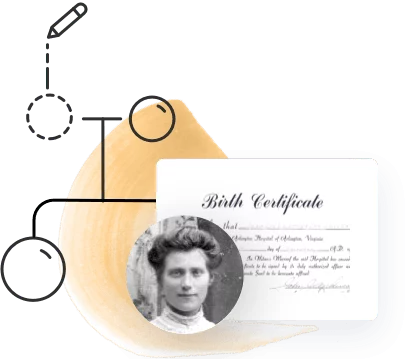
Once the research goals for a particular ancestor or branch of the family have been achieved, many family historians decide to transform the names, facts, and dates into a compelling story. Perhaps they’d like to make it more enjoyable for future generations, or maybe they’d like to turn the story into a fictionalized account which can be published as a short story or novel. In this article, I will give you some tools for transforming your family history research into an interesting story.
Before you begin, I suggest you research every relative whom you plan to include in your work, even if it will be fiction, and consult any living family members you plan to feature in your work to ask if there is any information they would prefer to keep private. You want to enjoy the writing, but you don’t want to make anyone uncomfortable by revealing confidential information.
Applying your research to craft a story
I recommend approaching your family history as though it were a work of fiction. This will make for a more compelling read as you connect with your ancestors — and it has the added bonus of giving you a better understanding of their actions within your historical timeframe.
I used the following outline method to help me sort and organize the facts as I wrote my own family’s story. Please do feel free to modify these tips to make it work for you.
Gathering facts
When I wrote my first historical short story, I was overwhelmed with the volume of information I had to wade through. Keep your files orderly and labeled. I used a combination of post-it notes and index cards. Don’t forget to number the cards — there’s nothing more frustrating to work with than a jumble of facts out of order.

Defining your characters
When you start your story, always mention the time period — e.g. WWII — and gather all the historical facts you can before inserting your major characters.
Step into your hero/heroine’s shoes and ask yourself:
- Where the family members were born. For example, if your roots are in a foreign country, your settings will help give more depth to your story, especially if the events occurred during a time of war and strife.
- How old am I when the story begins? People will empathize with a child growing up in the midst of battle.
- How old do I want to be when the story ends?
- What do I look like? Please don’t go overboard here. I don’t need to know that the heroine has Elizabeth Taylor’s violet eyes or Cary Grant’s cleft chin.
- What’s in my wardrobe? Do be period accurate. Reeboks don’t belong in WWI.
- What do I like to eat and where do I like to dine? Again, fast food is century-specific, and you must take your character’s income and employment into consideration.
- What is your view of the world you live in? Be careful here. It must fit the era of your book.
- What is most important to you in a relationship? Times have changed. Remember the one you’re writing in and portray your characters accurately.
- How do you handle good news and bad situations?
- Dangerous situations: If someone came toward you with a weapon, would you know how to defend yourself?
- Pets: What kind of animals did people in your historical period keep and what was the attitude people had towards domesticated animals? In many countries, they earn their keep and aren’t considered pets.
- Friends and family: How does your character feel about them?
- Partners and children: Do you want them? Don’t marry off your character in the beginning and have him/her ready to abandon either or both by the middle of the book. Again, think of how marriage and children were perceived for your time period.
- Hobbies: Does your character begin as a shy bookworm who summons courage to save lives, or is she/he a brave soul who has an unfortunate incident and retreats into a corner at the first sign of danger?
- Travel: Does your character prefer to stay put, or does he/she have a need for adventure in other countries that will influence her actions?
- Culture: Does your character like museums and art galleries or is he/she more comfortable spending a Saturday curled up with a good book?
- Books: Is your character an intellect or more inclined toward a graphic novel or a period piece?
- Emotions: Does your character cry at the sight of a wounded child/animal or have a hardened attitude toward either?
Probe your character for answers to all of these questions.
Story elements
The Dark Moment
You must keep your characters moving forward. Use all the above information to bring him/her to the Dark Moment, when all appears lost.
The story elements leading to THE END
Make every word count so that readers will want to keep reading. Don’t get so bogged down in descriptions and details that you forget to move the plot forward.
Growth
Your hero/heroine needs to undergo some kind of change from the beginning to the end of your story (also known as a character arc).
Conflict
Your story needs some kind of friction, tension, or conflict to move the plot forward. The best way to achieve all three is with a worthy villain who opposes what the protagonist is trying to do. Here, again, proceed with caution. You might want to use a new name to protect the true identity of the villain if his/her revelation will stress a family member reading your story.
Descriptions and setting
Character descriptions
Make sure you know what your hero/heroine and villain look like, and keep their descriptions handy as you write. It’s often easier to write if you can describe a character’s facial features.
Setting descriptions
It’s a good idea to keep setting descriptions handy as well — and be sure to verify the historical accuracy of the descriptions you have for places your character may spend time, including homes, restaurants, bookstores, pharmacies, etc.. Once you start writing, they help you to keep multiple places clearer in your mind. Unless you plan to keep your character in a confined area for the length of the story, as mentioned, you should have photos of places with dates where action/scenes take place.
I’ve given you the clay. Now, mold and shape it into a story that resonates with readers because you’ve taken the time to incorporate all of the elements that are integral to your era and locations for your family history.





